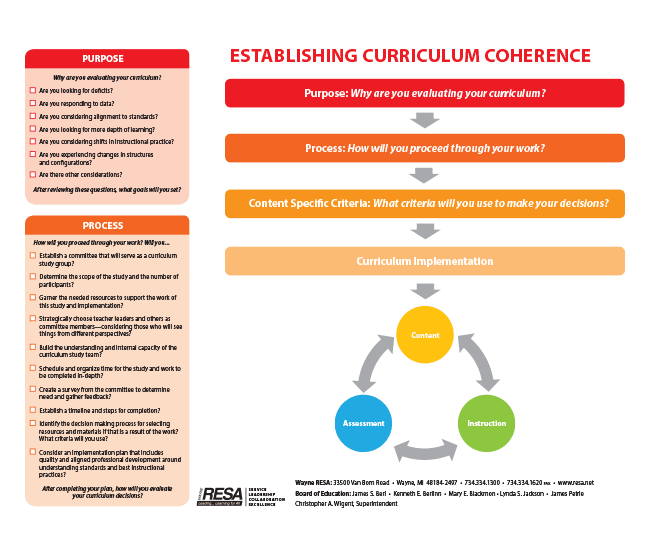Educational Content Areas

Wayne RESA provides support in curriculum, instruction, and assessment across the four major content areas:
Curriculum Coherence
Wayne RESA began the school year asking its constituents how we can best provide leadership and service. As a result, we heard a great deal of feedback regarding the seemingly ambiguous term “Curriculum Development”. In response to feedback, Wayne County Consultants established a team exclusively focused upon “Curriculum Development” from multiple perspectives in order to maximize service and provide superior support. The following sections will help local districts understand Curriculum Development and begin asking clear questions about the best way with which to begin the work at the local level.
Establishing Curriculum Coherence
What does curriculum development mean to you?
"It is difficult to give a definition for curriculum development, because it will always be affected very strongly by the context in which it takes place. We can look back in history and find out that the word curriculum originally came from a Latin word, which meant a racetrack that horses ran around. Today, we might call it a racecourse, and so we see that the words curriculum and course are closely related. There is a suggestion that something continuous is happening, maybe over a long time, although it is equally valid for short courses. We can think of curriculum development as a continuous process, which is relevant to the situation where it takes place, and flexible, so you can adapt it over time. As in a race, there may be a finishing point, but if you work in curriculum development, you will probably find out that the work does not end at a particular moment."
— From The World Agroforestry Center.
Purpose
Why are you evaluating your curriculum?
Purpose is everything! Without purpose—time, materials, and resources are often wasted. Purpose establishes a course of action. What has caused you to stop and reflect on your curriculum? Review the questions below and identify those that will help direct your work.
- Are you looking for deficits?
- Are you responding to data?
- Are you considering alignment to standards?
- Are you looking for more depth in learning?
- Are you considering shifts in instructional practice?
- Are you experiencing changes in structures and configurations?
- Are there other considerations?
After reviewing these questions, what goals will you set?
Process
How will you proceed through your work?
In order to be successful, you need the right people doing the right plan. Taking time and proceeding slowly will strengthen implementation. Studying together to create a common understanding enhances the decision process. Below is a list of possible ways to proceed with this work. Review the list and decide where you need to begin. The amount of time you devote to this process will directly impact the work. Go slow to go fast and set yourself up for success. Be sure to establish a timeline and assign tasks as you begin this work.
Will you...
- Establish a committee that will serve as a curriculum study group?
- Determine the scope of the study and the number of participants?
- Garner the needed resources to support the work of this study and implementation?
- Strategically choose teacher leaders and others as committee members—considering those who will see things from different perspectives?
- Build the understanding and internal capacity of the curriculum study team?
- Schedule and organize time for the study and work to be completed in depth?
- Create a survey from the committee to determine need and gather feedback?
- Establish goals and a timeline?
- Identify the decision making process for the purchase of materials if that is a result of the work? What criteria will you use?
Consider an implementation plan that includes quality and aligned professional development around understanding standards and best instructional practices?
Establishing a purpose and a process for this work are the first two steps in beginning the task of curriculum review. The third step is using agreed upon criteria to make content curriculum decisions. Finally, you will implement the curriculum cycle (Content – Instruction – Assessment). These last two steps will be discussed in future newsletters.
Establishing Curriculum Coherence Diagram

Curriculum Coherence Documents








